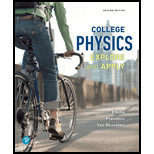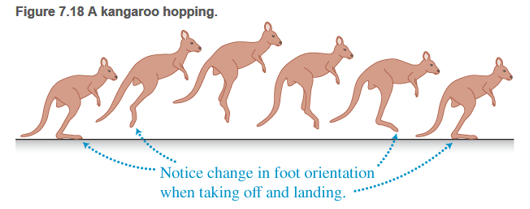
Concept explainers
BIO Kangaroo hopping Hopping is an efficient method of locomotion for the kangaroo (see Figure 7.18). When the kangaroo is in the air, the Earth-kangaroo system has a combination of gravitational potential energy and kinetic energy. When the kangaroo lands, its Achilles tendons and the attached muscles stretch-a form of elastic potential energy. This elastic potential energy is used along with additional muscle tension to launch the kangaroo off the ground for the next hop. In the red kangaroo, more than 50% of the total energy used during each hop is recovered elastic potential energy. This is so efficient that the kangaroo’s

The horizontal and vertical force components exerted by a firm surface on a kangaroo’s feet while it hops are shown in Figure 7.19a. the vertical force NS on k y (Figure 7.19b) varies: when the kangaroo is not touching the surface S, the force is zero; when it is pushing off, the force is about three times the gravitational force that Earth exerts on the kangaroo. The surface exerts a backward horizontal force (FS on K z) on the kangaroo’s foot while it lands and a forward horizontal force as it pushes off for the next hop (Figure 7.19c), similar to what happens to a human foot when landing in front of the body and when pushing off for another step when behind the body.

Which answer below is closest to the vertical height above the ground that the kangaroo reaches if it leaves the ground traveling with a vertical component of velocity of 2.5 m/s?
a. 0.2 m
b. 0.3 m
c. 0.4 m
d. 0.6 m
Want to see the full answer?
Check out a sample textbook solution
Chapter 7 Solutions
EBK COLLEGE PHYSICS
Additional Science Textbook Solutions
College Physics: A Strategic Approach (3rd Edition)
Introductory Chemistry (6th Edition)
Chemistry: An Introduction to General, Organic, and Biological Chemistry (13th Edition)
Microbiology: An Introduction
Human Anatomy & Physiology (2nd Edition)
Campbell Biology (11th Edition)
- A 70.0 cm, uniform, 40.0 N shelf is supported horizontally by two vertical wires attached to the sloping ceiling (Figure 1). A very small 20.0 N tool is placed on the shelf midway between the points where the wires are attached to it. Find the tension in the left-hand wire. Express your answer with the appropriate units.arrow_forwardFind the total bind Mev. binding energy for 13 Carbon, 6C (atomic mass = 13.0033554)arrow_forwardWhat is the 27 energy absorbed in this endothermic Auclear reaction 2] Al + 'n → 27 Mg + ! H? (The atom mass of "Al is 26.981539u. and that of 11 Mg is 26.984341u) MeVarrow_forward
- What is the energy released in this nuclear reaction 1 F + "', H-1 O+ He? 19 19 16 (The atomic mass of 1F is 18.998403 u, and that of 20 is 15.9949154) MeV.arrow_forwardWhat is the energy released in this B+ nuclear reaction خالد 2½ Al w/ Mg + ie? (The atomic mass of 11 Al is 23.9999394 and that > of 12 Mg is 23.985041 u) MeV.arrow_forwardWhat is the energy released / absorbed in this nuclear reaction 14 N+ & He → » O + ! N? (The atomic mass of 14 N is 14.003074u. 17N+ and that of 10 is 16.9991324). MeVarrow_forward
- Can someone help me answer this question thanks.arrow_forwardCan someone help me with this question thanks.arrow_forward4B. Four electrons are located on the corners of a square, one on each corner, with the sides of the square being 25 cm long. a) Draw a sketch of the scenario and use your sketch to b) Determine the total force (magnitude and direction) on one of the electrons from the other three?arrow_forward
- Portfolio Problem 3. A ball is thrown vertically upwards with a speed vo from the floor of a room of height h. It hits the ceiling and then returns to the floor, from which it rebounds, managing just to hit the ceiling a second time. Assume that the coefficient of restitution between the ball and the floor, e, is equal to that between the ball and the ceiling. Compute e.arrow_forwardPortfolio Problem 4. Consider two identical springs, each with natural length and spring constant k, attached to a horizontal frame at distance 2l apart. Their free ends are attached to the same particle of mass m, which is hanging under gravity. Let z denote the vertical displacement of the particle from the hori- zontal frame, so that z < 0 when the particle is below the frame, as shown in the figure. The particle has zero horizontal velocity, so that the motion is one dimensional along z. 000000 0 eeeeee (a) Show that the total force acting on the particle is X F-mg k-2kz 1 (1. l k. (b) Find the potential energy U(x, y, z) of the system such that U x = : 0. = O when (c) The particle is pulled down until the springs are each of length 3l, and then released. Find the velocity of the particle when it crosses z = 0.arrow_forwardIn the figure below, a semicircular conductor of radius R = 0.260 m is rotated about the axis AC at a constant rate of 130 rev/min. A uniform magnetic field of magnitude 1.22 T fills the entire region below the axis and is directed out of the page. R Pout (a) Calculate the maximum value of the emf induced between the ends of the conductor. 1.77 v (b) What is the value of the average induced emf for each complete rotation? 0 v (c) How would your answers to parts (a) and (b) change if the magnetic field were allowed to extend a distance R above the axis of rotation? (Select all that apply.) The value in part (a) would increase. The value in part (a) would remain the same. The value in part (a) would decrease. The value in part (b) would increase. The value in part (b) would remain the same. The value in part (b) would decrease. × (d) Sketch the emf versus time when the field is as drawn in the figure. Choose File No file chosen This answer has not been graded yet. (e) Sketch the emf…arrow_forward
 College PhysicsPhysicsISBN:9781305952300Author:Raymond A. Serway, Chris VuillePublisher:Cengage Learning
College PhysicsPhysicsISBN:9781305952300Author:Raymond A. Serway, Chris VuillePublisher:Cengage Learning Physics for Scientists and Engineers with Modern ...PhysicsISBN:9781337553292Author:Raymond A. Serway, John W. JewettPublisher:Cengage Learning
Physics for Scientists and Engineers with Modern ...PhysicsISBN:9781337553292Author:Raymond A. Serway, John W. JewettPublisher:Cengage Learning Physics for Scientists and Engineers, Technology ...PhysicsISBN:9781305116399Author:Raymond A. Serway, John W. JewettPublisher:Cengage Learning
Physics for Scientists and Engineers, Technology ...PhysicsISBN:9781305116399Author:Raymond A. Serway, John W. JewettPublisher:Cengage Learning College PhysicsPhysicsISBN:9781285737027Author:Raymond A. Serway, Chris VuillePublisher:Cengage Learning
College PhysicsPhysicsISBN:9781285737027Author:Raymond A. Serway, Chris VuillePublisher:Cengage Learning Principles of Physics: A Calculus-Based TextPhysicsISBN:9781133104261Author:Raymond A. Serway, John W. JewettPublisher:Cengage Learning
Principles of Physics: A Calculus-Based TextPhysicsISBN:9781133104261Author:Raymond A. Serway, John W. JewettPublisher:Cengage Learning Physics for Scientists and Engineers: Foundations...PhysicsISBN:9781133939146Author:Katz, Debora M.Publisher:Cengage Learning
Physics for Scientists and Engineers: Foundations...PhysicsISBN:9781133939146Author:Katz, Debora M.Publisher:Cengage Learning





